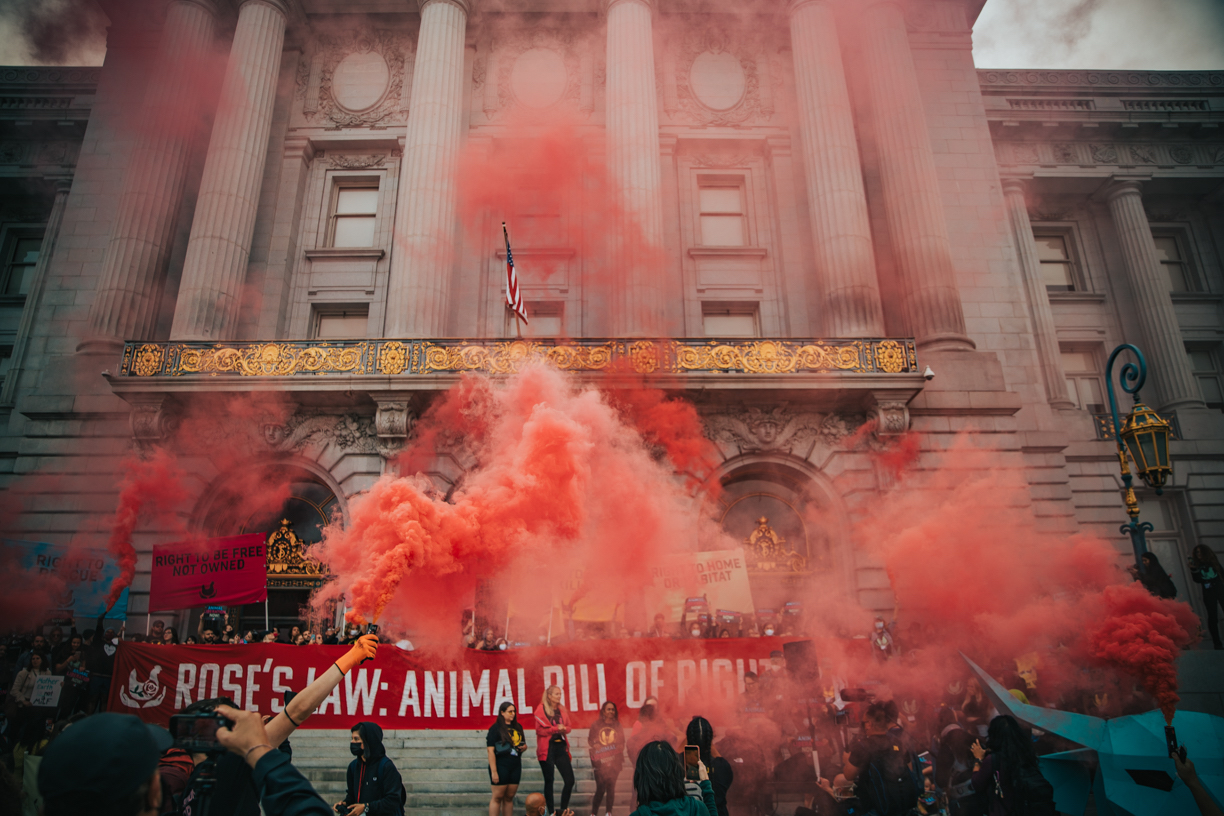Stigmatizing Eating Animals
By Zach Groff
This past Saturday, DxE members brought to a screeching halt a Wall Street Journal panel called "Why We Love Meat," with panelists and the audience storming out when faced with nonviolent stories of individual animals.

A package containing animal flesh has a sticker on it that reads "This is the body of someone who did not want to die."
I doubt anyone liked us. I doubt anyone was persuaded. I doubt anyone learned anything. But I think it was one of our most successful disruptions to date, and here's why: we set a new norm for everyone in the room that “meat” is not stigma-free, and that when you promote violence, you risk a nonviolent, disruptive response.
Our goal - and ultimately, one of the entire movement’s goals - is to create stable and powerful social norms against violence towards animals. Clearly, such stability requires that people largely accept these norms. With enough conviction and nonviolent courage, we can actually begin to enforce these norms before they are accepted, laying the groundwork for their adoption.
When it comes to eating animals, our society is in an extremely unstable place. Right and left, we see people trying to avoid thinking about the violence we inflict on our fellow animals. At the Wall Street Journal talk, the event description read "Putting the environmental and health considerations aside, we'll focus on the culinary and cultural aspects of eating meat." The moderator began by saying that in all the discussions of the environmental and health costs of meat, "what's hiding in plain sight is our love of meat." What is also hiding in plain sight is something they could not bear to mention, even briefly -- the mass killing of animals for food.
The life of an animal that must inevitably be taken (at a critically young age, as one of the panelists himself noted) is so disturbing and yet so built-in to the very idea of meat that it could scarcely be mentioned. If we admitted the sentience of other animals, then an hour-long discussion about carving up their bodies becomes twisted and sadistic indeed.
When we stood up and began sharing the stories of individual animals -- pulling on the powerful psychological phenomenon of the identifiable victim -- we inserted into that room a subject everyone wanted to hide. We upended a discussion that was premised on the denial of personhood to our fellow animals. We disrupted the charade of talking about destroying animals' lives with a thinly-calloused indifference to the animals themselves.
The result was that the audience faced a choice: continue discussing meat, with the pall of now-visible violence cast over the whole discussion, or end the discussion entirely and flee from the truth. The audience and panelists literally fled. With that, we established for them the beginning of a new norm: discuss “meat” if you want, but you will not discuss it without recognizing the animals whose lives -- and bodies -- it rips apart. This is what it looks like to stigmatize eating animals.

Over the past half-century, the establishment of a stigma around cigarettes has proved a potent force, reducing smoking from a universal habit to one that is widely frowned upon. Similarly, stigma around bigoted speech has made once-commonplace expressions require apologies when uttered by a public figure. The animal rights movement has seen the powerful effect of stigma when, in the 1990s, concerted campaigns around fur made wearing it a commonly-frowned-upon practice. Growing up as a child in the 1990s, I actually thought fur was illegal (even though it wasn't) because of how strong a stigma I saw around me.
Each of the stigmas noted above faces a powerful drawback, though, which reduces its power and does not apply to a movement to end all violence against animals. The stigma around cigarettes targets a personal habit whose primary and direct victim is the individual who smokes. This makes actual laws or ironclad norms against smoking problematic in a way that a law to ban violence by one person against another would not. The stigma around bigoted speech targets an act - speech - which our society largely views as sacrosanct.
Meanwhile, the 1990s campaigns against fur were frequently vitriolic, personal, and in many cases sexist. This goes against the spirit of nonviolence, which has been described by a nonviolence trainer DxE has worked with as "anger toward systems, compassion toward individuals."
Along these lines, our disruption maintained a calm, even compassionate tone as we shared the stories of individual animals, sparking an angry reaction not from the activists but from the audience.
So, while stigmas have worked powerfully against many practices, they are most potent when they nonviolently target an act that physically harms others. Wayne Hsiung has spoken eloquently about the campaign to end foot-binding in early 20th century China. A campaign of civil resistance made a millennia-old practice of blood feuds in Kosovo taboo. In our own time, nonviolent action has generated powerful social stigmas against overt discrimination, now punishable by law.
For these reasons, creating a stigma - a permanent pall of guilt backed by a threat of disruptive protests - attached to any event promoting violence against animals is a powerful way to reshape social norms. Much of the prevailing wisdom in the animal rights movement is about persuading individuals: how can we make ourselves likable? How can we customize our arguments to their tastes (something I wrote about recently)? Yet what this misses is that behavior can precede ideas, and a first step to changing hearts and minds about animals may be to stigmatize promoting violence against them.
When we, as animal liberationists, rise up against violence, we should not ask: "Do they like us?" We should instead ask: "Do they waver in their support for violence?" As one disgruntled audience member on Saturday muttered under their breath, "they are everywhere." If we can make that true, then we can change the world.
Other articles

Tulare County Dairy Farms Are Poisoning Latino Communities

The Case for Systemic Change




